

The Easiest Way To Master The Fretboard!
The series was developed visually, because people natively think visually. You do not have to interpret a picture. You can understand it by looking at it.
And when you combine it with knowledgable text, the meaning and rules of music will jump out at you!
Immediately you will begin to see into the instrument and develop an understanding that is not possible any other way.
This is one of the main reasons this series of books carry a lifetime guarantee. We back up our words with an iron clad policy that has been in place for years!
eBooks are delivered instantly!
By Tim Gillespie
This month I want to get started by touring my personal recording studio. This is important because much of my guitar work today centers around this approach. I am by no means an expert at sound engineering but I have enough experience over the years to jump right in.
I have always had a recording studio of sorts. I started out with simple tape recorders that quickly gave way to 4 track tape recorders. Those were analog tape systems that featured quite a bit of hiss when you started to work the different tracks. Next came personal song workstations like the Korg PXR4, another personal 4 track recorder but this one was digital and exported MP2 files which were then converted to MP3 files in Cakewalk.
Cakewalk Home Recording Studio was a big improvement as now we could record digital files that could be directly played back using software. The software worked entirely inside your computer and sound card. This was the beginning of the true digital home studio.
All of these approaches were compromised and hardly produced polished results. That fortunately has now changed.
Now I just plug into my music interface which flows directly onto Logic Pro (software) and then into my hard drive as it is processed in a digital sequencer (Logic Pro). The big improvement is the audio interfaces that are now available for both Mac and Windows systems as well as the sequencer software. This is the heart of the system and we are going to look at mine in a few paragraphs.
But first let's take a look at the overall recording system and how it works. Here is a picture of my little studio. Mind you this is only a 10' x 12' room, tucked far away from everyone else. My daily practices take place here using the same equipment. I use my sequencer to record my own music as well as cover songs done by other artists. And I will tell you right now, it works great!
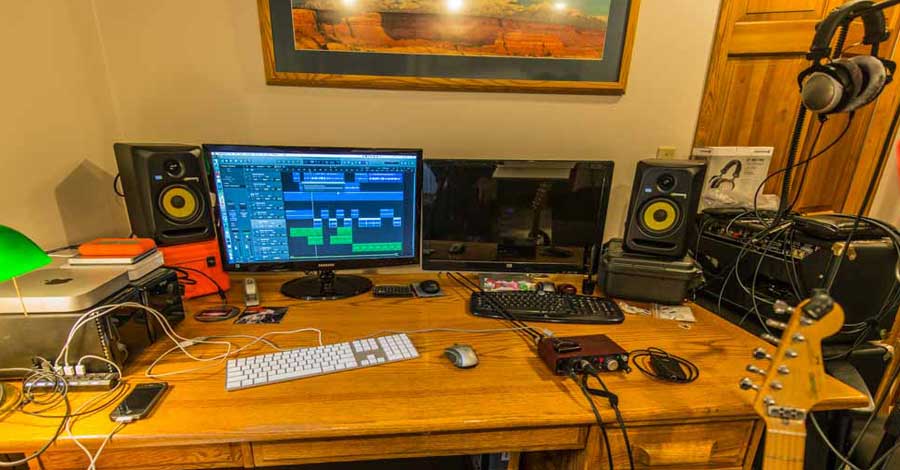
Okay I get it, it looks like a desktop. And it is! Remember this is a personal system. That said it is quite capable of generating great recordings. Much better than I have ever been able to record previously. And it is much easier too!
So here is the rundown from left to right. The system is powered by a Mac Mini, quad cord processor with 8 GB of RAM. Not a lot but certainly enough. It is sitting on a Drobo disk array. The recording happens on a magnetic disk that is the secondary disk on the system, which is contained in the Mac Mini. Projects are stored in the short term on the Drobo disk arrays which work pretty well. The Speakers are actually near field monitors that are tuned for the exact center of the seat. Near field monitors are preferred for recording because they are known to have dead flat output. And they are very accurate as long as you are in the exact right position. In fact they are breath taking to listen to and can actually be tuned for the environment they are in.
The first display monitor (left side) is hooked up to the Mac Mini and runs the sequencer. It is also the network file and print server. A sequencer is a recording system that allows different audio tracks to be recorded and then played back in sequence so a song can be created. The sequencer gets the audio input from the music interface, a midi track or a drummer track. You can also import all sorts of song files like mp3, AAC, m4a, etc.. You can plug a guitar, microphone or keyboard / midi controller into the audio interface and the sequencer will then record the instrument or voice. These are a huge step up from 4 track tape recorders.
The next monitor is hooked up to a Windows system in case we need to use software that is only available for Windows. It is not used that often, although it could just as easily act as the center of a system.
 In the front of the desk on the right hand side is a small red box. This is the music interface. The instruments and microphones are connected directly into the red box which then sends the signals into the computer and into the sequencer. The sequencer then processes the sound file, records it and finally plays it back using the audio interface to pipe the signal to the speakers. If you set the sequencer up correctly there is usually very little delay as the signal travels throughout the system and out to the speakers. I love it!
In the front of the desk on the right hand side is a small red box. This is the music interface. The instruments and microphones are connected directly into the red box which then sends the signals into the computer and into the sequencer. The sequencer then processes the sound file, records it and finally plays it back using the audio interface to pipe the signal to the speakers. If you set the sequencer up correctly there is usually very little delay as the signal travels throughout the system and out to the speakers. I love it!
The microphone stand is barely visible on the right hand side (big image) and it has a Shure 48 mic on it with a pair of studio quality headphones hanging off of them. I find I need both the speakers and the headphones for all recording projects. These headphones can pick up everything in the background. I often use them to see how professional some videos are or are not. I can hear televisions in other rooms behind closed doors in some videos with these headphones. They simply do not miss anything. But it is worth pointing out that a small audio interface cannot push headphones of this quality so a microphone amplifier is necessary. The one I use is actually a small portable amp that costs about $60. You can spend thousands of dollars on just the headphone amplifier, but this small portable unit actually works pretty well.
The guitar in the image is just a 25 year old Fender Squire that I keep tuned down to D. I play a few songs in D tuning and it is easier to just pick up a different guitar than re-tune my main guitar. Mainly I play a Gibson Les Paul Custom Sunburst these days. But I still like the old Squire. It should be noted that my friends will not let me call it a Stratocaster, even thou it is. But it should not be confused with a classic American made Fender Stratocaster. It is not that, it is a Squire. But I still play it almost every day.
Behind the mic stand is a Music Man head and speaker. I like this one because of the rich tube sound for using with acoustic guitars. It also works great with the electric guitars. Mostly I go directly into the audio interface with my guitar but sometimes I still just use the old amp with a few old Boss stomp boxes.
I also keep a couple of keyboards around like an old Yahama DX-21 and a Oxygen 25 key midi controller for background keyboards and strings. You can actually use it for almost any midi instrument including drums and the sequencer recognizes it instantly. I will probably buy a bigger one sometime next year. I would like a four octave keyboard instead of just two. This controller actually adds a lot and I highly suggest one as a part of your system.
1. The Sequencer.
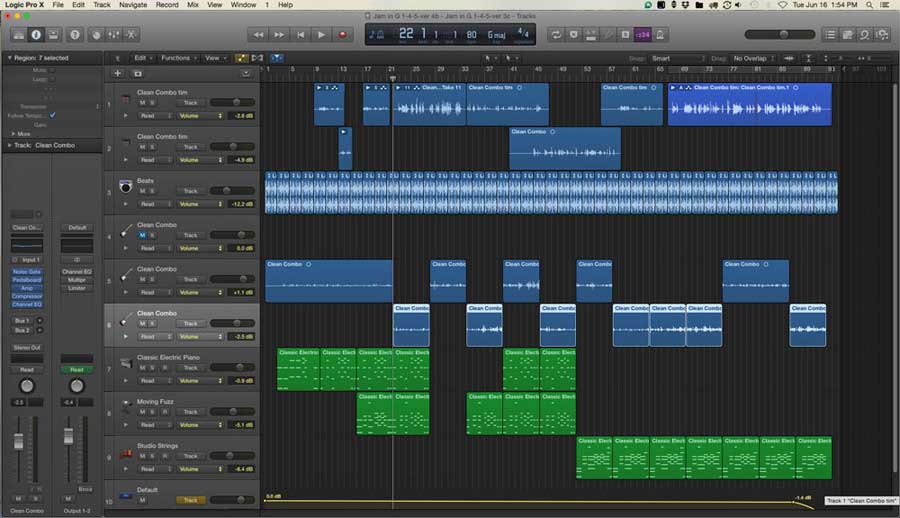
This is a screen shot of my sequencer. A sequencer is a piece of software you install on your computer. This one is Logic Pro from Apple. If you use Windows, don't worry, you can easily find one that works on that platform. Avid Pro Tools is the top choice for both Mac and Windows, but it starts at about $700 and climbs from there. Logic Pro is $199 at the Apple App. store and Garage Band is free with a Mac and $6 to upgrade to the latest version which is very similar to Logic Pro. In fact it uses the same code base.
The big difference between Garage Band and Logic Pro is that Logic Pro is a professional tool with features to handle just about any situation and plenty of patch options to dial in the sound of an instrument. Garage Band is stripped down. I went right for the professional tool since I know I will end up there anyway and I do not want to waste time with a second piece of software that I will quickly outgrow. Eventually I may move to Pro Tools, which is what most professional studios use. If you can afford it and you are serious, go right to the best software available. And then get training. I like videos I can watch over and over. If you just want to check this out a little and you have a Mac, try Garage Band. You can do quite a bit in it. The Focusrite 2i2 comes with Ableton Live Lite recording software, which is another option for Windows based systems.
On the left side of the image above you have the information for the specific instrument and patch that is highlighted in the second column. The second column shows the actual track and what kind of instrument is being recorded and what patch is being used. A patch is just the software configuration file of the specific speaker, stomp boxes and effects that are used to record the instrument. Logic Pro has plenty of pre made patches available for most instruments and you can always make your own, just by editing their preset patches (easy). The third column are the actual tracks. I am including a You Tube video from DanceTech which fully builds the song "Knocking On Heaven's Door" in Logic Pro. I highly suggest everyone watch this video as this guy really knows Logic Pro. He will not only show you how the program works, he will also show you how to record in it as well as some cool tricks everyone should be aware of. This is highly recommended, even if you do not intend to use Logic Pro. What he will show you can be applied to any sequencer.
A sequencer is a great tool for anyone who plays an instrument and wants to record it or hear it played back. It can greatly inform you what you sound like when you practice (if you record it) and is immensely powerful in helping you become a better guitar player and / or singer. I personally will not be without one.
2. Audio Interface
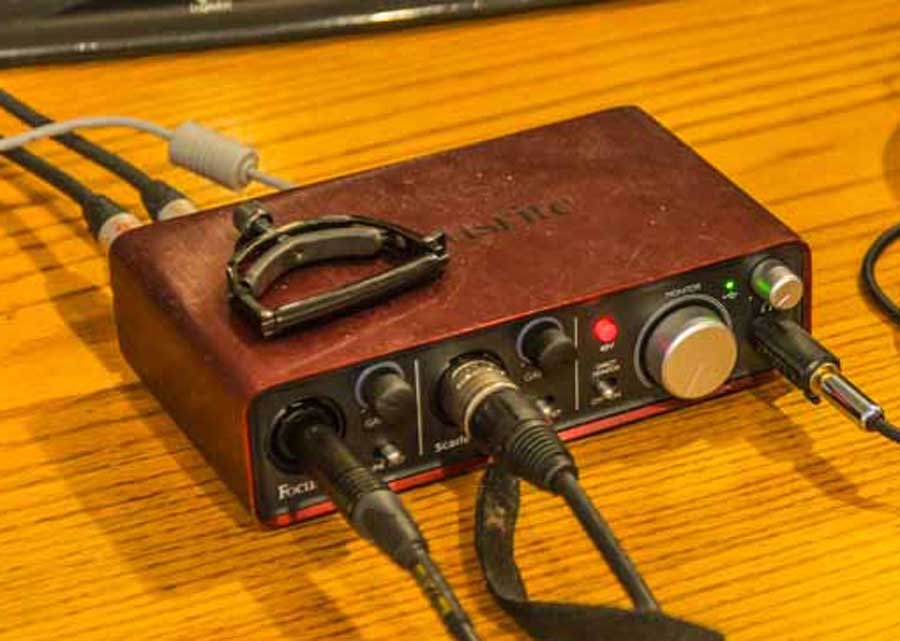
I use the Focusrite Scarlett 2i2 as my audio interface, however I will also pick up the Focusrite 6i6 later this year. I need more inputs as well as outputs. The 2i2 gives you two audio inputs and two audio outputs. You can see the inputs here. It has both a 1/4" jack and an XLR microphone jack in each connector. The small black knobs are to adjust the gain and the gray band lights up in green, orange and red to alert you what the state of your signal is. Green means good signal, orange signifies you are about to clip the sound wave and red means you are clipping the sound wave. It is not as good as analog pin meters but it works well enough. I usually stay in the green/orange bands. I like to flirt with clipping and put out a red (hot) signal.
The red light that is on signifies I am using 48v. phantom power for my microphone. A full 48v. is not always available with audio interfaces and is one of the elements that makes a difference between units. Microphones often need a power boost if you do not go through a PA system or mixing board, and the 2i2 can supply the needed power to push microphones. This is very important in a home studio and the 2i2 does a very good job of this. All in all, this is a very clean audio interface.
The outputs are on the back and they are 1/4" female. There is also another interface called the Focusrite Solo which is very similar to the 2i2, but the outputs are RCA female connectors. I need 1/4 inch so the 2i2 is a better choice for me. The big dial is the volume knob for speakers and the small switches tell the unit which inputs to use (1/4" or XLR). The small knob on the upper right side is the headphone jack. It takes quarter inch and I have a 1/4" male to 3.5mm female adapter on it. The headphone output is rather weak on the 2i2, which is not uncommon. If you use a professional pair of headphones (250 ohms or higher), you will need to boost the signal with a headphone amplifier. You can spend from $60 to over $2,000 on just the amplifier.
Here is an image of the setup with the headphones and the Fiio E11K portable headphone amplifier ($60). The headphone amp can also be used to boost the signal from your iphone or even car stereo if you have a jack into the stereo. It helps mine in my Ford Explorer quite a bit.
Apogee makes an audio interface called the Duet which is class leading for this type of interface. It is a very nice interface but pricey. It lists for about $650, while the Focusrite 2i2 is available for about $150. Both are highly recommended. The Duet gives you four outputs and two inputs, which can be nice to have.
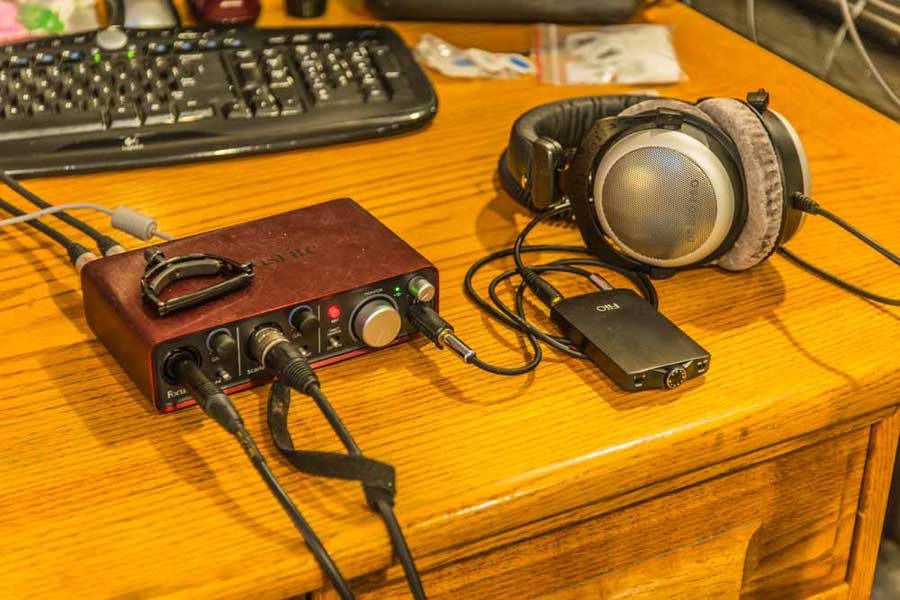
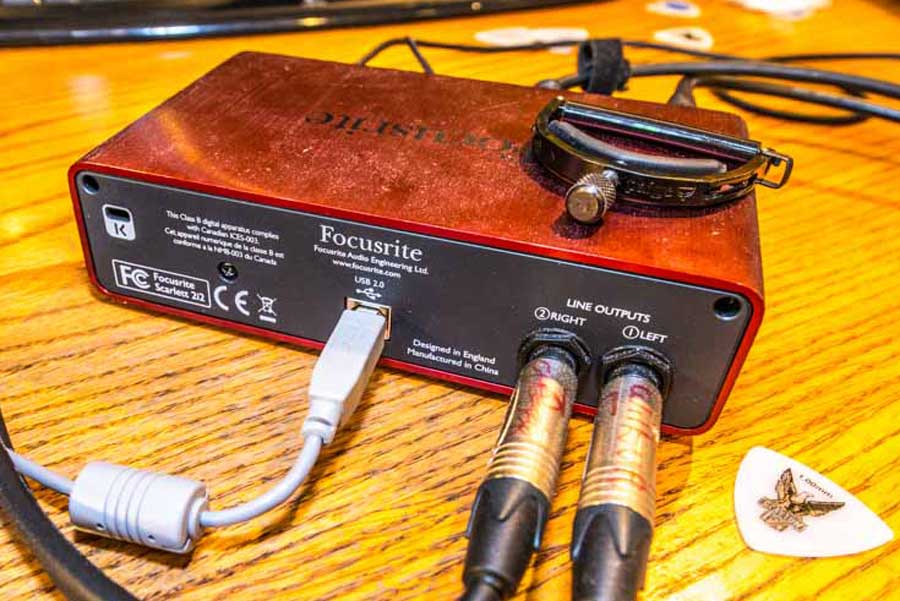
Note: Focusrite also includes 'sound plug ins' for Logic Pro and they sound great. They are effects you can apply to a guitar or other instrument that change the sound as it comes in. These 'plug ins' work great and are highly recommended. The video link for the Focusrite Scarlett Solo below will go over some of these.
The second image is the back side of the 2i2. You can see the USB-2 power connection as well as the 1/4" speaker / monitor connections. I use 1/4" to XLR connectors on either end of the cables for my monitors, Wilbur and Chester. The monitors have XLR inputs and that is a very stable connection. So I had a couple of cables made up. You can see the XLR connections on the monitor backs which is coming up.
Note: Notice that there is no discreet power cord as this unit receives it's power from the computer through the USB cable. That means if you go into a friendly neighborhood music store to play some guitars you can bring your smallest laptop with your sequencer loaded on it and your 2i2 audio interface with your headphones and play any guitar right through the audio interface and into your headphones. You can test the guitar out with any combination of speaker cabinet and stomp box combination and get a real good idea of what the guitar would be like to play every day. That is reason alone to keep this interface around. It also works great for when everyone is asleep and you want to play or when you go camping.
Below: This setup is extremely mobile. The laptop is the smallest Mac Air. It has Logic Pro loaded on it, which is allowed by the license. The audio interface is plugged right into the laptop and is also powered by it. The headphones connect into the music interface as does the guitar. Complete with everything you need to go guitar shopping. I use this in my living room when I want to play guitar and watch television at the same time or when I want to play on the back porch. I actually love this feature.
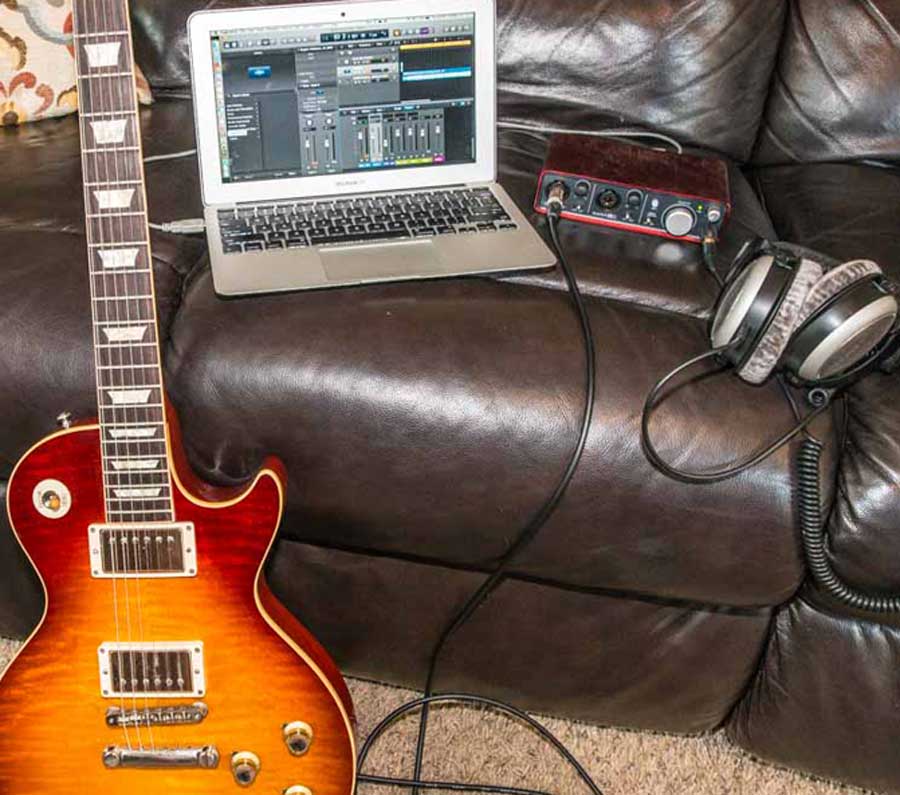
3. Headphones
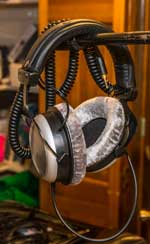 I use the Beyerdynamic 880 DT recording headphones ($300) and I cannot give them a better recommendation. They are absolutely awesome. They have a very clear stage presence and a completely flat response. I certainly apply EQ to them when I listen using iTunes or other software, but for recording and listening back you want a flat response. And these deliver that in spades. There is a slight uptick at 5 KVA (often times the frequency of a female backup singer) , but I doubt that will even be apparent. It does seem to lessen after you break them in. HIGHLY RECOMMENDED!
I use the Beyerdynamic 880 DT recording headphones ($300) and I cannot give them a better recommendation. They are absolutely awesome. They have a very clear stage presence and a completely flat response. I certainly apply EQ to them when I listen using iTunes or other software, but for recording and listening back you want a flat response. And these deliver that in spades. There is a slight uptick at 5 KVA (often times the frequency of a female backup singer) , but I doubt that will even be apparent. It does seem to lessen after you break them in. HIGHLY RECOMMENDED!
You want headphones to isolate parts of your music or to hear yourself sing in the midst of other instruments. These headphones use an open design which means you can hear sounds outside of them and your sound leaks out. Not great for listening while sitting close to another person because they can hear the music leaking from your headphones, but for recording studios, you cannot beat them. I use them for everything. Beyer states that they are actually semi-open, but really they are open (IMHO). These will quickly become your favorite headphones. My wife loves them.
So remember the audio interface takes in the instrument and voice signals, sends them to the sequencer for processing. The signal is then sent back out the audio interface for distribution to the speakers and / or the headphones. You have to be careful when singing into a microphone which is then playing that signal out a monitor or speaker, because of feedback through the mic back into the system. Usually it is preventable but sometimes it presents issues. Which is another good reason to get a great pair of headphones.
You record most song parts with headphones on and use speakers to listen as you play the song back. If you use speakers during recording you risk creating a feedback loop between the microphone and the speakers. It can also create a muddy recording if a bunch of white noise gets in.
So all good recording systems need to have a good pair of headphones available. They don't have to be great but they should be good.
4. Monitors
I use the KRK Rokit 5 G3 near field monitors. These monitors sell for $150 apiece and compare favorably with much more expensive monitors. In a word, they are great. Each monitor can be tuned for corners and walls in back and if you are looking for the absolutely best computer speakers you can buy, then look no further. These monitors will totally rock any computer station. These are powered monitors, so you must supply 110v to them.
Near Field monitors are a very precise monitor but they are highly directional. Meaning you need to point them right at your head, and make sure the speaker level is adjusted to be at the same level of your ears. If you do that, you will be amazed at the response you get. Even if you are just standing in the room, these are awesome monitors. Sometimes we bring them into the living room if we really want to listen to our best sounding speakers. In my mind, they compare to B&W speakers, which I consider the best stereo speakers. I realize there are many very good choices.
You can spend much more on monitors, in fact you can spend thousands, but for a personal high quality studio you do not need to do that. Rokit 5 G3 monitors are very competitive price wise and will deliver very good perfectly flat sound. I am very happy with these speakers.
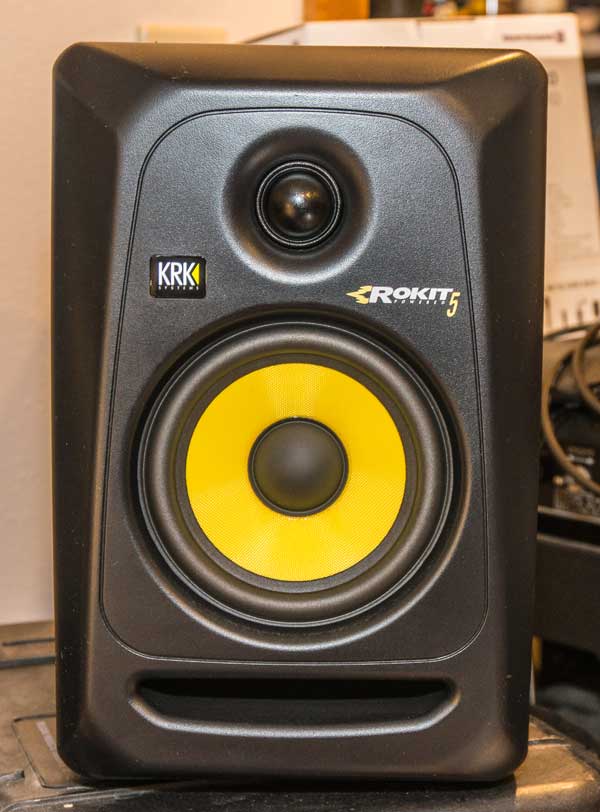
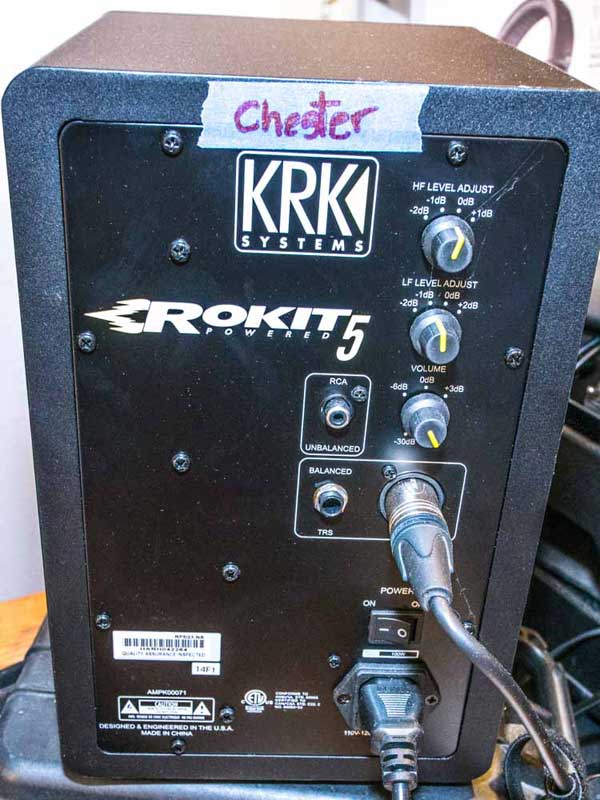
Here is a shot of the back of Chester (yes I name my speakers). You can see the High Frequency adjustment which is at 0 db. The Low Frequency adjustment is at -1 db because there is a wall right behind the cabinet. You would use -2 db if it were a corner. The monitor will accept RCA unbalanced, 1/4" balanced and XLR balanced inputs. I like XLR because it is a very sure connection and no one else can use the cables so they never disappear. XLR and 1/4" connectors sound identical. Wilbur is set up the same way, only with a LF value of -2 db for the corner.
Note of Interest: Joey Shapiro of Gorilla Snot, http://www.gorillasnotusa.com/, passed on a great idea to me a number of years ago. When you fill your studio with speakers and monitors, don't forget to get a very average to poor set of speakers so you can hear your music the way most people will hear it. As terrible as this sounds, there is some truth to the idea. Most of the time music is played on less than high fidelity speakers. Often times you can barely hear the music because of the volume and the poor quality of available speakers. As we try and reach a state of perfection with our equipment, it is good to put some equipment towards hearing your music played on less than ideal equipment. Joey is the owner of Gorilla Snot and lives in my community. He is a working musician and plays out regularly. He also makes a mean margarita. Thanks Joey!
5. Keyboard / Midi Controller
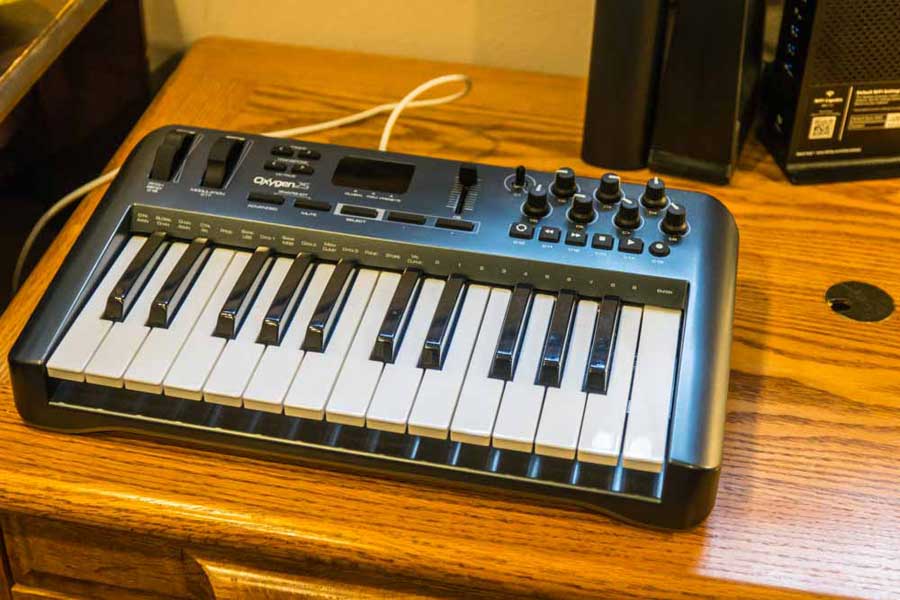
I use the Oxygen 25 midi controller about $115 new. This works very well with the sequencer to serve as the controller for all sorts of midi instruments. I use it as a grand piano, orchestral strings, some bass lines and other keyboard effects. You can use it for drums too, but I prefer actual drum pads. The new version has drum pads on it.
Every studio needs some kind of Midi controller, and this one is very basic. It has nice weighted keys and enough controls that I seem to be happy. You need to determine how well your sequencer of choice handles midi interfaces, instruments and instrument patches as they are all different. Logic Pro actually is one of the better sequencers for midi controllers.
Midi is a great interface for software instruments. Midi allows you to assign a software patch to the controller which turns the controller into whatever the patch is set up to be. It could be a grand piano, an upright bass, a violin or even a clarinet. There are hundreds of software patches you can use your midi controller to play. And this opens up major possibilities for adding instruments and sounds. And of course you can edit the individual midi notes as much as you like.
Out of this little cheap instrument can come a very wide variety of sounds that can greatly increase what you can do in a studio, particularly when backing up a guitar.
6. Microphones
This is actually more a personal choice rather than a suggestion. I use the Shure SM48, which is very similar to the SM58, which is one of the most common high quality microphones around. You can easily spend as much money as you have on good microphones and everyone's taste is different on this one.
These Shure microphones are actually intended for live reproduction and I may find that there are better recording microphones than these. Since I use this setup for daily practice I do like the unidirectional aspect of the SM48. And I prefer the sound of my voice over the SM48 rather than the SM58, although I would like to test that again.
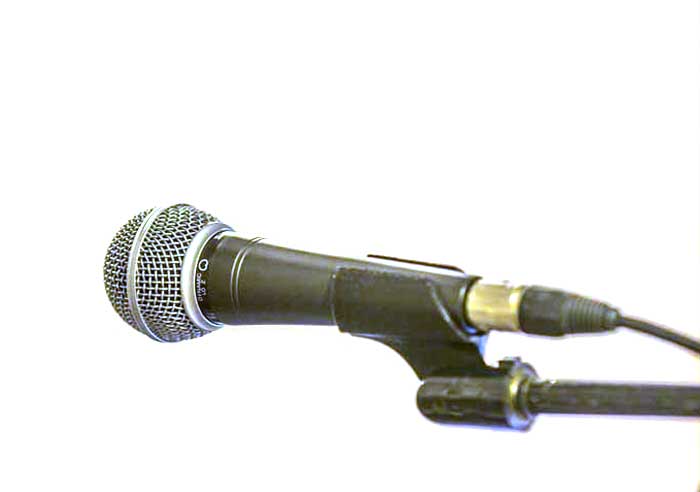
My Vision
I also use it to try out ideas for songs. I can quickly test out different ideas and build up support for each guitar track. I can create a drum track in just a few minutes and change it every few measures if I want. And when I get an idea I want to turn into a full blown song, I have all the tools to obsess over any or all the details I care to. And since it is digital, the final product should be very clean if you recorded it well.
This brings up an important point to this conversation. What am I trying to do? Am I interested in putting together a low cost studio or am I trying to aim a little higher?
The answer is both! I usually start with equipment that I think provides a great solution yet is an economical choice. That said, it is important to know that I violate that rule all the time. Often I go for the best piece of equipment available. The Beyerdynamic DT-880 headphones are a good example of that. And if I really wanted to go all out, I probably would have purchased Pro Tools instead of Logic, but truth be known, I will probably own both before too long.
Same goes for microphones. The Shure SM48 is my current favorite for performing but I have not really tried all that many. I would very much like to bring in a large diaphragm condenser mic but that is one of those things I would need to try to see how it matches up with my voice. It is also going to depend on the results I get as I do more recordings of better quality.
I use this system for learning and playing back songs from other artists too. I can loop any section and easily setup each song with the best patches for my guitar. If you use Logic Pro for practice you have to go into the preference settings and make sure playback is not isolated to the current track under focus. That allows all tracks to play back normally. There is quite a bit of customizing that can be done, some of which is important.
Recordings do not lie. If you are not sure you are singing or playing a part correctly, simply recording it and playing it back can be a real eye opener. But be warned, it can be quite rude when you listen to your recordings at first. But you can quickly improve and this tool can help you to see the areas that need the most work.
Home recording studios are pure fun. I can spend countless hours playing guitar with all of these tools. Sometimes my three piece group gets together and uses this system for practice, which is why I need more inputs. My uses for this system keep expanding.
We live in a time when the tools available for creativity are exploding and they are getting better and better at helping us turn our desire for creativity into real music. These tools can greatly help any guitarist that is willing to work at it.
And what you can get back from these tools can be priceless. So consider exploring music sequencers today along with all the tools that help you to get the most out of your creativity. It can make a huge difference in what you do with a guitar and your music.
Knocking On Heaven's Door - By Dancetech
This video is highly recommended if you are interested in understanding Logic and want to see it in action. This guy is brilliant and his introduction to recording is a must see if you are a singer / player / songwriter. If you are interested in constructing songs and recording them, then stop what you are doing and watch this one. Dancetech also has MANY, MANY more videos on Logic Pro and they are all highly recommended.
Visit their YouTube channel by clicking on this link.
In this second video you can get an introduction to the Focusrite Scarlett Solo. This is very similar to the Focusrite 2i2, except it has RCA jacks out the back instead of 1/4 female jacks. This is a great chance to learn about Focusrite audio interfaces.
Training Videos
Logic Pro X Essential Training
I also want to make you aware of some training videos for Logic Pro. Lynda.com has a series that I use from Scott Hirsch that is quite good called Logic Pro X Essential Training. Training is very helpful when learning how to use a sequencer. I watch each video several times as I am constantly learning new tricks. There are lots of YouTube videos on Logic Pro but few of them are great for actually training. This training set of videos can teach you how to use the system to it's fullest.
Thanks again, - Tim